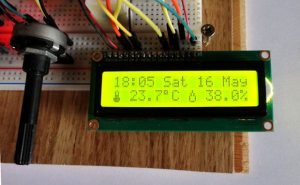These 7 steps will drive you through the “construction” of a thermo-hygrometer with clock on Arduino UNO.
Data and time, humidity and temperature will be shown on a LCD 16×2 display .If you have purchased a LCD display and want to know how to properly solder a pin header to it, take a look at our tutorial “Yet another tutorial on how to solder”.
Each step of this tutorial is independent from the others. So, if you are looking for an easy way to make your DS3231 work (for example) this tutorial is also suitable for you.
What you need to follow all steps of this tutorial is:
- Arduino UNO
- A USB cable
- The Arduino IDE installed on your computer
- A MB-102 breadboard
- Set of Dupont cables
- DHT22(humidity and temperature sensor)
- DS-3231 (A cheap but accurate real time clock)
- LCD 16×2 display
- A 10k Ohm linear potentiometer
- A 2N3904 transistor (or a 2N2222)
- Number 3 10k Ohm resistors (1/4 Watt)
- A pushbutton
- Preferably, a better text editor than Arduino IDE
Another very useful thing (but not strictly required) is a small wooden board where fixing Arduinio and breadboard. Get some short self tapping screws if you decide to follow this advice.
Even if this tutorial seems to be not easy, it can be done by newbies as well if followed step-by-step,
YOUR COMMENTS AND SUGGESTIONS ARE WELCOME!
Step 1: Make Your DHT22 Work
The first step is downloading and installing the library needed by DHT22 sensors.
Download the zip file attached in this step. Into this folder there are two files which have to stay into the sub-folder \DHT. If you are on Windows, install the library by putting the \DHT folder into the directory:
C:\Program Files (x86)\Arduino\libraries
So, the two files dht.cpp and dht.h have to be contained in a folder named DHT and no other sub-folders have to be made. Click here for more info about adding new libraries.
DHT22 connections
Before uploading the code to your Arduino, you need to connect the DHT22 sensor properly.
Read more: Thermohygrometer with clock and LCD display on Arduino UNO

